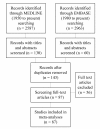Post-stroke infection: a systematic review and meta-analysis
- PMID: 21933425
- PMCID: PMC3185266
- DOI: 10.1186/1471-2377-11-110
Post-stroke infection: a systematic review and meta-analysis
Abstract
Background: stroke is the main cause of disability in high-income countries, and ranks second as a cause of death worldwide. Patients with acute stroke are at risk for infections, but reported post-stroke infection rates vary considerably. We performed a systematic review and meta-analysis to estimate the pooled post-stroke infection rate and its effect on outcome.
Methods: MEDLINE and EMBASE were searched for studies on post-stroke infection. Cohort studies and randomized clinical trials were included when post-stroke infection rate was reported. Rates of infection were pooled after assessment of heterogeneity. Associations between population- and study characteristics and infection rates were quantified. Finally, we reviewed the association between infection and outcome.
Results: 87 studies were included involving 137817 patients. 8 studies were restricted to patients admitted on the intensive care unit (ICU). There was significant heterogeneity between studies (P < 0.001, I(2) = 97%). The overall pooled infection rate was 30% (24-36%); rates of pneumonia and urinary tract infection were 10% (95% confidence interval [CI] 9-10%) and 10% (95%CI 9-12%). For ICU studies, these rates were substantially higher with 45% (95% CI 38-52%), 28% (95%CI 18-38%) and 20% (95%CI 0-40%). Rates of pneumonia were higher in studies that specifically evaluated infections and in consecutive studies. Studies including older patients or more females reported higher rates of urinary tract infection. Pneumonia was significantly associated with death (odds ratio 3.62 (95%CI 2.80-4.68).
Conclusions: Infection complicated acute stroke in 30% of patients. Rates of pneumonia and urinary tract infection after stroke were 10%. Pneumonia was associated with death. Our study stresses the need to prevent infections in patients with stroke.
Figures
References
-
- Vermeij FH, Scholte op Reimer WJ, de Man MP, van Oostenbrugge RJ, Franke CL, de Jong G, de Kort PL, Dippel DW. Stroke-associated infection is an independent risk factor for poor outcome after acute ischemic stroke: data from the Netherlands Stroke Survey. Cerebrovasc Dis. 2009;27:465–471. doi: 10.1159/000210093. - DOI - PubMed
-
- Katzan IL, Cebul RD, Husak SH, Dawson NV, Baker DW. The effect of pneumonia on mortality among patients hospitalized for acute stroke. Neurology. 2003;60:620–625. - PubMed
-
- Nederkoorn PJ, Westendorp WF, Hooijenga IJ, de Haan RJ, Dippel DW, Vermeij FH, Dijkgraaf MG, Prins JM, Spanjaard L, van de Beek D. Preventive antibiotics in stroke study: rationale and protocol for a randomised trial. Int J Stroke. 2011;6:159–163. doi: 10.1111/j.1747-4949.2010.00555.x. - DOI - PubMed
Publication types
MeSH terms
LinkOut - more resources
Full Text Sources
Medical



